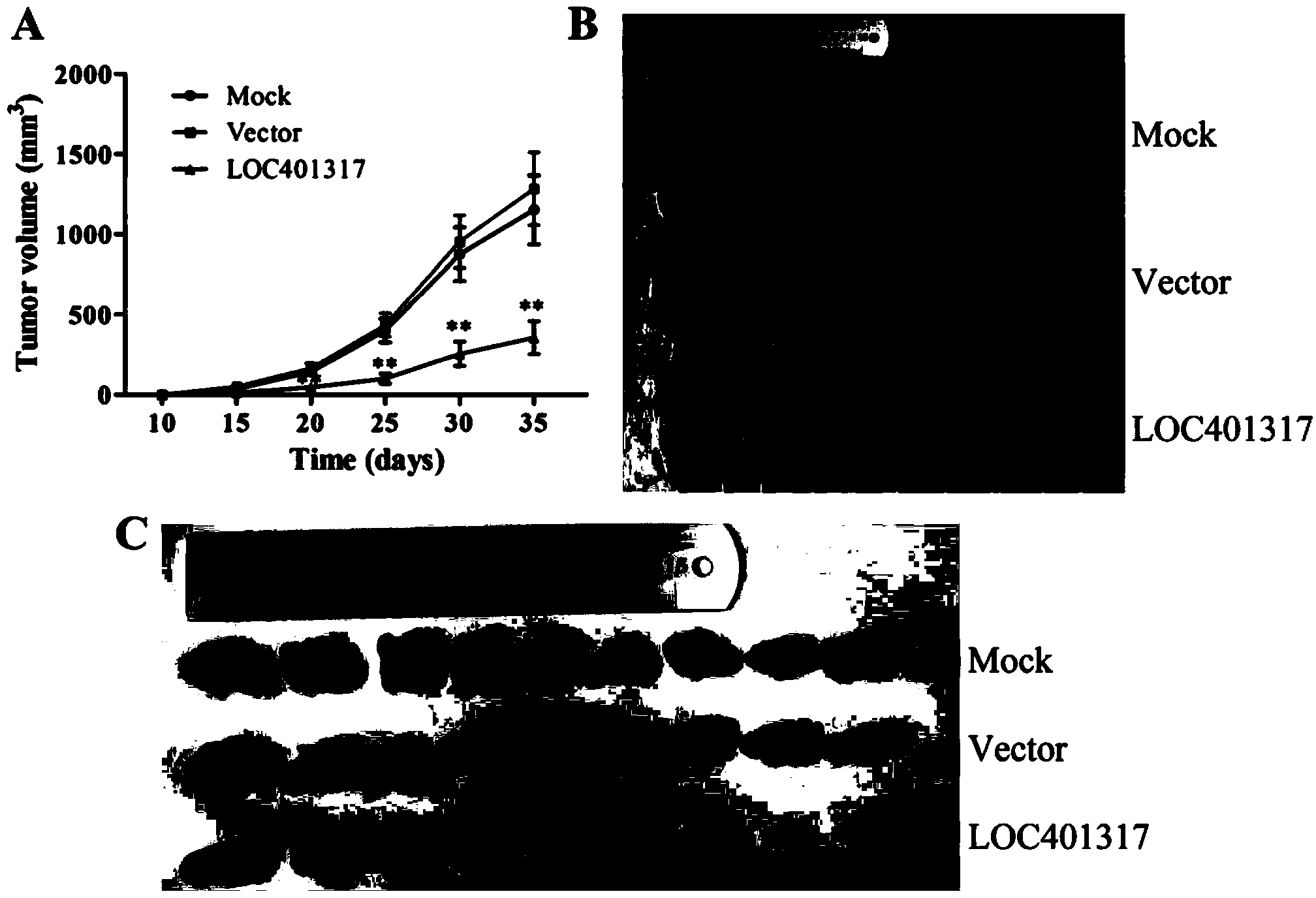In situ hybridization probe, reagent and application of long non-coding RNA LOC401317
A long-chain non-coding and in-situ hybridization technology, which is applied in the field of in-situ hybridization probes of long-chain non-coding RNA LOC401317, can solve the problems of unknown lncRNA function and other problems, and achieve the effect of important promotion and application prospects and far-reaching clinical significance.
- Summary
- Abstract
- Description
- Claims
- Application Information
AI Technical Summary
Problems solved by technology
Method used
Image
Examples
Embodiment 1
[0042] Example 1, the TP53 gene was introduced into nasopharyngeal carcinoma cells, and the expression of lncRNA LOC401317 was significantly upregulated
[0043] 1. Materials and methods:
[0044] 1.1 Reagents and kits
[0045] Common biochemical reagents such as agarose (agrose) and gel recovery kits were purchased from Shanghai Huashun Biological Engineering Co., Ltd. Mini Kit (Qiagen) extraction kit extracts RNA with improved quality, SuperScript TM The III (Invitrogen) kit reverse transcribed RNA into cDNA. The Luciferase Reporter Assay Kit (Dual-Luciferase Reporter Assay System) was purchased from Promega. The nasopharyngeal carcinoma cells HNE2 used in the present invention are preserved by the Cancer Institute of Central South University. The RPMI1640 medium and fetal bovine serum used for cell culture, and the trypsin used for digesting cells are all products of Gibco, USA. The lncRNA chip is a product of Agilent, the chip size is 4*180K, and there are 46506 lnc...
Embodiment 2
[0076] Example 2, lncRNA LOC401317 inhibits nasopharyngeal carcinoma cell cycle arrest and induces apoptosis
[0077] 1. Materials and methods
[0078] 1.1 Reagents and kits
[0079] Restriction enzymes Nhe I and EcoR I and T4DNA ligase were purchased from TakaRa Company; TRIZOL TM Reagent (Invitrogen); Plasmid Extraction Kit, Gel Recovery Kit (OMEGA); Reverse Transcription Kit (Promega); Proteinase K, DNase I, RNAsin, RNase A (GBICOL Company); Tetramethylazolazolium Blue ( MTT, Sigma); antibiotic G418 (Ameresc).
[0080] 1.2 Construction of pcDNA3.1-LOC401317 eukaryotic expression vector
[0081] We chose pcDNA3.1 blank vector (from Invitrogen Company) to construct the overexpression vector of LOC401317. We chose Nhe I and EcoR I restriction sites for digestion of pcDNA3.1 vector and inserted LOC401317 sequence into this site.
[0082]The steps to construct pcDNA3.1-LOC401317 eukaryotic vector are as follows:
[0083] 1) Using the cDNA of HNE2 cells transfected with TP...
Embodiment 3
[0133] Example 3, LOC401317 inhibits the growth of nasopharyngeal carcinoma cells in a nude mouse transplantation tumor model
[0134] 1. Materials and methods
[0135]Thirty male BALB / C nude mice, 4 weeks old, weighing 19±2g, were purchased from Shanghai Slack Experimental Animal Co., Ltd. All nude mice passed the quality inspection and were bred under specific pathogen-free (SPF) conditions in the Experimental Animal Department of Central South University.
[0136] The construction of LOC401317 eukaryotic expression vector and the preparation, cell culture and transfection of polylysine-modified silicon nanoparticles are the same as in Example 2.
[0137] Take 2×10 HNE2 cells transfected with LOC401317 or pcDNA3.1 blank vector, and HNE2 cells (Mock) without any treatment 6 Inject into the subcutaneous of the armpits of nude mice respectively, observe and compare the growth of the tumors, measure the size of the transplanted tumors with a vernier caliper across the skin fro...
PUM
 Login to View More
Login to View More Abstract
Description
Claims
Application Information
 Login to View More
Login to View More - R&D
- Intellectual Property
- Life Sciences
- Materials
- Tech Scout
- Unparalleled Data Quality
- Higher Quality Content
- 60% Fewer Hallucinations
Browse by: Latest US Patents, China's latest patents, Technical Efficacy Thesaurus, Application Domain, Technology Topic, Popular Technical Reports.
© 2025 PatSnap. All rights reserved.Legal|Privacy policy|Modern Slavery Act Transparency Statement|Sitemap|About US| Contact US: help@patsnap.com



